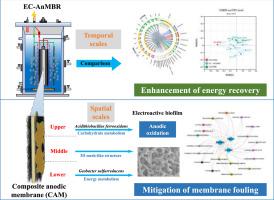当前位置:
X-MOL 学术
›
Water Res.
›
论文详情
Our official English website, www.x-mol.net, welcomes your feedback! (Note: you will need to create a separate account there.)
Biogas upgrading and membrane anti-fouling mechanisms in electrochemical anaerobic membrane bioreactor (EC-AnMBR): Focusing on spatio-temporal distribution of metabolic functionality of microorganisms
Water Research ( IF 12.8 ) Pub Date : 2024-03-30 , DOI: 10.1016/j.watres.2024.121557 Yule Han , Wanjiang Li , Yijing Gao , Teng Cai , Jiayi Wang , Zhaobin Liu , Jian Yin , Xueqin Lu , Guangyin Zhen
Water Research ( IF 12.8 ) Pub Date : 2024-03-30 , DOI: 10.1016/j.watres.2024.121557 Yule Han , Wanjiang Li , Yijing Gao , Teng Cai , Jiayi Wang , Zhaobin Liu , Jian Yin , Xueqin Lu , Guangyin Zhen

|
Electrochemical anaerobic membrane bioreactor (EC-AnMBR) by integrating a composite anodic membrane (CAM), represents an effective method for promoting methanogenic performance and mitigating membrane fouling. However, the development and formation of electroactive biofilm on CAM, and the spatio-temporal distribution of key functional microorganisms, especially the degradation mechanism of organic pollutants in metabolic pathways were not well documented. In this work, two AnMBR systems (EC-AnMBR and traditional AnMBR) were constructed and operated to identify the role of CAM in metabolic pathway on biogas upgrading and mitigation of membrane fouling. The methane yield of EC-AnMBR at HRT of 20 days was 217.1 ± 25.6 mL-CH/g COD, about 32.1 % higher compared to the traditional AnMBR. The 16S rRNA analysis revealed that the EC-AnMBR significantly promoted the growth of hydrolysis bacteria ( and ) and methanogenic archaea ( and ). Metagenomic analysis revealed that the EC-AnMBR promotes the upregulation of functional genes involved in carbohydrate metabolism ( and ) and methane metabolism ( and ), improving the degradation of soluble microbial products (SMPs)/extracellular polymeric substances (EPS) on the CAM and enhancing the methanogens activity on the cathode. Moreover, CAM biofilm exhibits heterogeneity in the degradation of organic pollutants along its vertical depth. The bacteria with high hydrolyzing ability accumulated in the upper part, driving the feedstock degradation for higher starch, sucrose and galactose metabolism. A three-dimensional mesh-like cake structure with larger pores was formed as a biofilter in the middle and lower part of CAM, where the electroactive had high capabilities to directly store and transfer electrons for the degradation of organic pollutants. This outcome will further contribute to the comprehension of the metabolic mechanisms of CAM module on membrane fouling control and organic solid waste treatment and disposal.
中文翻译:

电化学厌氧膜生物反应器(EC-AnMBR)中的沼气提质和膜防污机制:关注微生物代谢功能的时空分布
通过集成复合阳极膜(CAM)的电化学厌氧膜生物反应器(EC-AnMBR)是提高产甲烷性能和减轻膜污染的有效方法。然而,CAM上电活性生物膜的发育和形成,以及关键功能微生物的时空分布,特别是代谢途径中有机污染物的降解机制尚未得到很好的记录。在这项工作中,构建并运行了两个 AnMBR 系统(EC-AnMBR 和传统 AnMBR),以确定 CAM 在代谢途径中对沼气升级和减轻膜污染的作用。 EC-AnMBR 在 20 天的 HRT 下的甲烷产量为 217.1 ± 25.6 mL-CH/g COD,比传统 AnMBR 高出约 32.1%。 16S rRNA分析表明EC-AnMBR显着促进水解细菌(和)和产甲烷古菌(和)的生长。宏基因组分析表明,EC-AnMBR 促进碳水化合物代谢 ( 和 ) 和甲烷代谢 ( 和 ) 相关功能基因的上调,改善可溶性微生物产物 (SMP)/细胞外聚合物 (EPS) 在 CAM 上的降解,并增强阴极上的产甲烷菌活性。此外,CAM生物膜在有机污染物沿其垂直深度的降解方面表现出异质性。具有高水解能力的细菌聚集在上部,驱动原料降解以提高淀粉、蔗糖和半乳糖的代谢。在CAM的中下部形成具有较大孔隙的三维网状滤饼结构作为生物过滤器,其中电活性物质具有直接存储和转移电子以降解有机污染物的能力。该成果将进一步有助于理解CAM模块在膜污染控制和有机固体废物处理处置方面的代谢机制。
更新日期:2024-03-30
中文翻译:

电化学厌氧膜生物反应器(EC-AnMBR)中的沼气提质和膜防污机制:关注微生物代谢功能的时空分布
通过集成复合阳极膜(CAM)的电化学厌氧膜生物反应器(EC-AnMBR)是提高产甲烷性能和减轻膜污染的有效方法。然而,CAM上电活性生物膜的发育和形成,以及关键功能微生物的时空分布,特别是代谢途径中有机污染物的降解机制尚未得到很好的记录。在这项工作中,构建并运行了两个 AnMBR 系统(EC-AnMBR 和传统 AnMBR),以确定 CAM 在代谢途径中对沼气升级和减轻膜污染的作用。 EC-AnMBR 在 20 天的 HRT 下的甲烷产量为 217.1 ± 25.6 mL-CH/g COD,比传统 AnMBR 高出约 32.1%。 16S rRNA分析表明EC-AnMBR显着促进水解细菌(和)和产甲烷古菌(和)的生长。宏基因组分析表明,EC-AnMBR 促进碳水化合物代谢 ( 和 ) 和甲烷代谢 ( 和 ) 相关功能基因的上调,改善可溶性微生物产物 (SMP)/细胞外聚合物 (EPS) 在 CAM 上的降解,并增强阴极上的产甲烷菌活性。此外,CAM生物膜在有机污染物沿其垂直深度的降解方面表现出异质性。具有高水解能力的细菌聚集在上部,驱动原料降解以提高淀粉、蔗糖和半乳糖的代谢。在CAM的中下部形成具有较大孔隙的三维网状滤饼结构作为生物过滤器,其中电活性物质具有直接存储和转移电子以降解有机污染物的能力。该成果将进一步有助于理解CAM模块在膜污染控制和有机固体废物处理处置方面的代谢机制。



























 京公网安备 11010802027423号
京公网安备 11010802027423号